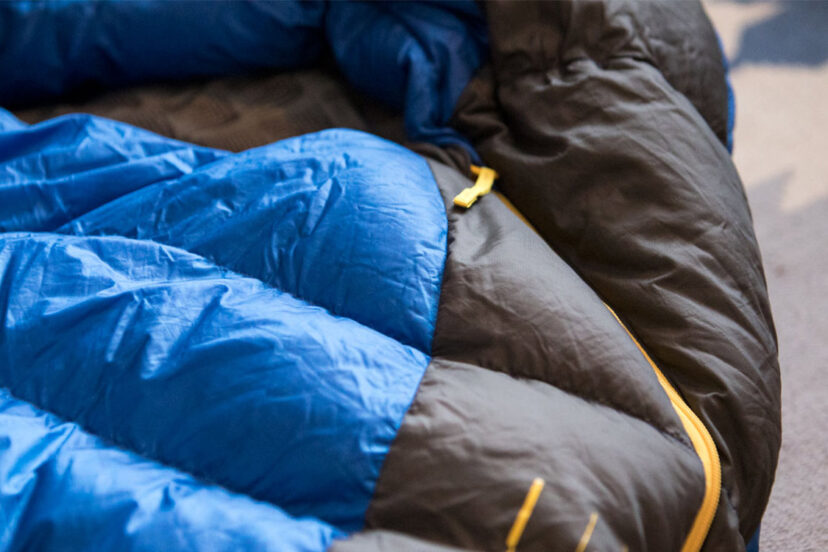How to Store Sleeping Bags?
Sleeping bags, the cosy cocoons that keep us warm on our outdoor adventures, are often neglected when it comes to care and maintenance. Proper storage is essential not only to preserve their quality, but also to ensure they function optimally every time they are used. Whether you’re a casual camper or a seasoned hiker, understanding the nuances of sleeping bag storage can make all the difference in your outdoor experience. So how do you properly store a sleeping bag? Find out in our article “How to Store Sleeping Bags?”
The art of storing a sleeping bag is more intricate than one might assume. It’s not just about finding a spot in the closet. It’s about ensuring the bag’s longevity, maintaining its insulation properties, and preventing any potential damage. With the right knowledge, you can ensure that your sleeping bag remains in prime condition, ready to accompany you on countless adventures.
Importance of Proper Storage
A sleeping bag’s primary function is to trap air, acting as an insulator to keep you warm. When stored improperly, its insulation can get compromised, affecting its performance. Moreover, factors like moisture, extreme temperatures, and compression can degrade the material, reducing the sleeping bag’s overall lifespan. Proper storage, therefore, is not just about space-saving; it’s about preserving the bag’s very essence.
Lifespan Extension
Every outdoor enthusiast knows that good gear is an investment. And like any investment, you want to ensure it lasts. By storing your sleeping bag correctly, you can significantly extend its lifespan. This not only gives you a better return on your investment but also ensures that you have a reliable piece of equipment for all your adventures. Over time, even the smallest preventive measures can prevent wear and tear, ensuring that your sleeping bag remains functional for years.
Maintaining Bag’s Insulation
The insulation, be it down or synthetic, is the heart of a sleeping bag. It’s what traps the air and keeps you warm. However, when a sleeping bag is compressed for extended periods, this insulation can lose its loft, reducing its effectiveness. By ensuring proper storage, you can maintain the bag’s loft, ensuring that it provides consistent warmth trip after trip.
A Step-by-Step Guide
- Clean Your Sleeping Bag: Before storing, ensure your sleeping bag is clean. Dirt and body oils can degrade the material and insulation over time. Follow the manufacturer’s instructions for washing, which typically involves using a gentle cycle and specific detergents suitable for the bag’s material.
- Ensure It’s Dry: After cleaning, or after any use, make sure the sleeping bag is thoroughly dry. Lay it out in a well-ventilated area, away from direct sunlight, until it’s completely dry. This step is crucial to prevent mold and mildew growth.
- Avoid Compression: While compression sacks are great for backpacking or traveling, they’re not ideal for long-term storage. Continual compression can damage the insulation and reduce the bag’s effectiveness.
- Use a Storage Sack or Bag: Many sleeping bags come with a larger, breathable storage sack. This sack allows the bag to maintain its loft, which is essential for insulation. If your sleeping bag didn’t come with one, consider purchasing a cotton or mesh storage sack.
- Consider Hanging: If you have the space, hanging your sleeping bag is an excellent storage option. This method ensures no compression whatsoever and allows the insulation to maintain its loft. Use wide hangers to distribute the weight evenly.
- Choose the Right Environment: Store your sleeping bag in a cool, dry place. Avoid damp basements or hot attics. Extreme temperatures and humidity can damage the bag’s materials and insulation.
- Keep Away from Pests: Ensure the storage area is free from pests like mice, which might find the insulation a cozy nesting material. Consider using storage solutions that seal or placing natural repellents like lavender or cedar nearby.
- Regularly Check and Air Out: Every few months, take your sleeping bag out of storage to air it out. This practice helps to maintain the insulation’s loft and ensures no moisture has built up.
- Avoid Storing Near Sharp Objects: Ensure that the storage area doesn’t have sharp objects or chemicals that might damage or stain the sleeping bag.
- Fold or Roll Occasionally: If you’re storing your sleeping bag for an extended period, consider changing its position occasionally. Instead of always folding it, roll it up, or vice versa. This variation ensures that the insulation isn’t always compressed in the same spots.
By following these steps, you’ll ensure that your sleeping bag remains in top condition, ready for many more adventures. Proper storage extends the life of your sleeping bag and ensures it performs optimally when you need it.
Pre-storage Cleaning
Before you even think about storing your sleeping bag, it’s crucial to ensure it’s clean. This doesn’t mean it needs a thorough wash after every trip, but it should be free from significant dirt, debris, and any moisture. Cleaning before storage prevents any residues that might degrade the material over time and ensures that the bag is fresh and ready for its next adventure.
- Hand Wash vs. Machine Wash: The debate between hand washing and machine washing has been ongoing. While some sleeping bags can handle the rigors of a machine wash, others, especially those with down insulation, might require a gentler hand wash. Always refer to the manufacturer’s guidelines. Remember, it’s not just about cleaning; it’s about preserving the material and insulation.
- Drying Techniques: Drying a sleeping bag is as crucial as washing it. Never wring out a sleeping bag. Instead, lay it flat to air dry, ensuring it’s spread out evenly. If you’re using a dryer, opt for a low-heat setting. Periodically fluff the bag during the drying process to ensure even drying and to maintain the insulation’s loft. Remember, moisture is a sleeping bag’s enemy, so ensure it’s completely dry before storage.
Proper Folding Techniques
When it comes to storing sleeping bags, the way you fold them can make a significant difference in maintaining their quality. Proper folding ensures that the insulation inside the bag is not overly compressed, which can lead to a loss of loft and reduced insulation capabilities. It’s essential to be gentle and methodical, ensuring that the bag is laid out flat, with no twists or folds that might stress the material or seams.
Rolling vs. Stuffing
The debate between rolling and stuffing a sleeping bag is age-old. Rolling involves laying the bag flat, folding it lengthwise, and then rolling it tightly from the bottom up. This method is neat and can be more space-efficient for storage. On the other hand, stuffing involves pushing the sleeping bag into its storage sack without any specific order. While this might seem haphazard, it ensures that the insulation isn’t compressed in the same way every time, which can be beneficial for the bag’s longevity. Both methods have their merits, and the choice often comes down to personal preference and the specific design of the sleeping bag.
Storage Solutions
- Storage Bags: Many sleeping bags come with a larger, breathable storage sack designed specifically for long-term storage. Unlike the compact compression sacks used for backpacking, these storage bags give the sleeping bag room to breathe and maintain its loft.
- Hanging Method: If you have the space, hanging your sleeping bag is an excellent way to store it. This method ensures that the insulation remains evenly distributed and doesn’t get compressed. You can use a hanger with broad shoulders or multiple hooks to spread out the weight.
- Under-Bed Storage Containers: For those with limited closet space, sliding storage containers designed to fit under beds can be a great solution. Ensure the container is clean and dry, and avoid tightly packing the sleeping bag.
- Vacuum Storage Bags: If space is at a premium, vacuum-sealed storage bags can be used. However, this should be a short-term solution, as prolonged compression can damage the insulation of the sleeping bag.
- Dedicated Shelf Space: If you have a shelving unit or a dedicated gear closet, allocate a specific shelf for your sleeping bag. Lay it out loosely, ensuring it’s not squished or compressed by other items.
- Storage Bins: Large plastic storage bins can be used, especially if you have multiple sleeping bags. Make sure the bin is dry and clean. Place the sleeping bags loosely without compressing them.
- Mesh Bags: Some prefer using large mesh bags, as they allow the sleeping bag to breathe while keeping it protected from dust and pests.
Remember, regardless of the storage solution you choose, it’s crucial to store your sleeping bag in a cool, dry place away from direct sunlight. This will ensure the longevity and effectiveness of your sleeping bag for many adventures to come.

Factors to Avoid During Storage
While proper storage techniques are essential, it’s equally crucial to understand what to avoid. Certain factors can significantly reduce the lifespan of your sleeping bag, and being aware of them ensures that your gear remains in top condition for years to come.
- Moisture and Dampness: One of the primary enemies of sleeping bags, especially those with down insulation, is moisture. Storing a damp or wet sleeping bag can lead to mold and mildew growth, which can damage the bag and pose health risks. Always ensure your sleeping bag is completely dry before storing it.
- Extreme Temperatures: Avoid storing your sleeping bag in places with extreme temperatures, such as attics or uninsulated garages. Fluctuating temperatures can degrade the materials and reduce the bag’s lifespan.
- Pests: Insects and rodents can cause significant damage to sleeping bags. Ensure the storage area is free from pests. Using sealed containers or bags can offer an additional layer of protection.
- Compression: While compression sacks are great for backpacking trips, prolonged compression can damage the insulation and reduce the bag’s effectiveness. When storing for extended periods, allow the bag to loft fully.
- Direct Sunlight: Prolonged exposure to UV rays can weaken the fabric and fade the colors of your sleeping bag. Always store your bag away from direct sunlight.
- Sharp Objects: Avoid storing your sleeping bag near sharp objects or tools that could puncture or tear the fabric. Even small tears can lead to significant insulation loss.
- Chemicals and Solvents: Exposure to harsh chemicals, solvents, or even strong detergents can degrade the materials of your sleeping bag. Ensure your storage area is free from such substances.
- Tight Spaces: Storing your sleeping bag squished between heavy items or in a cramped space can cause it to lose its shape and compromise its insulation capabilities.
By being aware of these factors and taking steps to avoid them, you can ensure that your sleeping bag remains in top condition, ready for your next adventure.

Regular Maintenance and Checks
Like any piece of equipment, regular maintenance and checks are crucial for a sleeping bag. Periodically take your sleeping bag out of storage, give it a good shake to fluff up the insulation, and check for any signs of damage or wear. This not only ensures that your bag is ready for your next adventure but also allows you to address any issues before they become significant problems. Regular maintenance ensures that your sleeping bag remains a reliable and effective piece of your outdoor gear arsenal.
FAQs
Can I store my sleeping bag in its compression sack?
It’s best to avoid long-term storage in compression sacks as it can damage the insulation.
How often should I air out my sleeping bag?
It’s good practice to air it out after every trip and before storing it.
Is it necessary to clean the sleeping bag before storage?
Yes, to remove any dirt, oils, or residues that might degrade its material.
What if my sleeping bag gets wet during a trip?
Ensure it’s completely dry before storing to prevent mold growth.
How can I tell if my sleeping bag’s insulation is compromised?
If the bag feels less puffy or doesn’t provide the same warmth, the insulation might be compromised.




